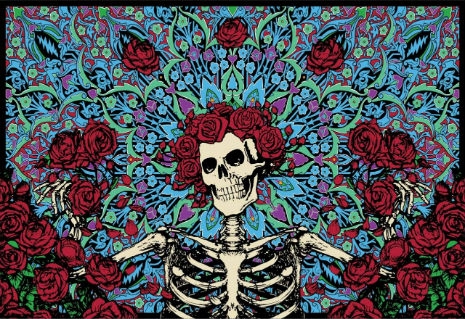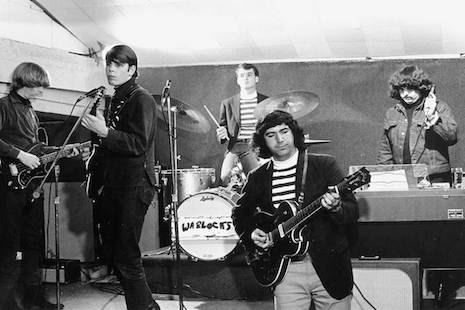
In 1965, Jerry Garcia and Bob Weir and Ron “Pigpen” McKernan and Phil Lesh were in a Bay Area outfit called the Warlocks. (Quite astonishingly, the band that would become the Velvet Underground was also operating as the Warlocks at that exact same juncture.) The first show where the band performed as the Grateful Dead occurred on December 4, 1965, in San Jose, at one of Ken Kesey’s Acid Tests.
The story of Jerry seeing the words “Grateful Dead” in a dictionary is a well-established part of Deadhead lore. Jerry saw the words in a dictionary and a sunbeam splashed on the page and the words on the page glowed in a beatific halo or whatnot.
Actually, here’s the story, as recounted in Blair Jackson’s Garcia: An American Life:
It was sometime in November 1965, while the band and a few friends were sitting around Phil’s apartment on High Street [Seriously, people? High Street??] in Palo Alto, smoking DMT and thumbing through a gargantuan Funk and Wagnalls dictionary, that the group’s name was revealed (cue biblical trumpets!). As Jerry said in his oft-quoted 1969 description of the episode, “There was ‘grateful dead,’ those words juxtaposed. It was one of those moments, y’know, like everything else on the page went blank, diffuse, just sort of oozed away, and there was grateful dead. Big black letters edged all around in gold, man, blasting out at me, such a stunning combination. So I said, ‘How about Grateful Dead?’ And that was it.” Later, he noted, “Nobody in the band liked it. I didn’t like it, either, but it got around that that was one of the candidates for our new name and everyone else said, “Yeah, that’s great.” It turned out to be tremendously lucky. It’s just repellent enough to filter curious onlookers and just quirky enough that parents don’t like it,” he added with a laugh.
But haven’t you ever wondered just what kind of dictionary has an entry for “Grateful Dead,” anyway? It seems like an awfully weird term to stick in on the same page as gravel.

The Warlocks in action, 1965
There’s a pretty solid piece of reporting on the Grateful Dead’s official website that does a good job of explaining how this came about. It’s not a straightforward story, and (as befits the mindset of, say, a lexicographer) the details matter.
Some Grateful Dead fans did spend significant time trying to track down the dictionary that Jerry might have been perusing, but to no avail. And in fact the lack of any such dictionary popping up in these searches may have led to the rise of an alternate theory about The Egyptian Book of the Dead, which does in fact feature the phrase “grateful dead” as well—but had nothing to do with Jerry’s idea for the name, at least not directly.
As the Dead’s website tells it, a Deadhead named Kimball Jones finally found the elusive dictionary, which turned out to be the 1955 edition of The Funk and Wagnalls New Practical Standard Dictionary, Britannica World Language Edition:
Jones contacted the band’s office, providing photocopies of the entry and title page; images of those pages would eventually appear in The Official Book of the Deadheads, finally laying the question to rest. Jones donated his copy of the dictionary to the Grateful Dead Archive, where it is currently on display.
As the article asks later, “The esoteric nature of the entry, and its rarity, raise an interesting question: how did such a specialized entry come to appear in a popular dictionary?”
The reason “Grateful Dead” was in the dictionary derives from a woman named Maria Leach, who worked for Funk and Wagnalls and had made lexicographical contributions “in the fields of folklore and mythology” and was also “the editor of the company’s Dictionary of Folklore, Mythology, and Legend, which has the other appearance of the grateful dead as an entry. ... in a real way, Maria Leach can be considered the godmother of the Grateful Dead.”
One wonders if Maria Leach ever even heard of the Grateful Dead before her death in 1977, when she was in her eighties. It seems quite likely that a lexicographer who was publishing books in 1949 (the year that Funk and Wagnalls came out with Dictionary of Folklore, Mythology, and Legend) would almost certainly, twenty years later, not even be aware of all those “younguns” with their loud guitars and such. In fact, Maria Leach was born in 1892 and attended Earlham College in Richmond, Indiana, whose curriculum was largely shaped by the teachings of the Quakers, so you know, it doesn’t seem too probable.
Even more interestingly, her (quite substantial) bio on Wikipedia does not mention her considerable role in the naming of one of the biggest acts in rock and roll history. Her Dictionary of Folklore, Mythology, and Legend, which sounds utterly fascinating, can be acquired on Amazon for a surprisingly reasonable sum.)
Here’s a scan of the 1955 edition of the dictionary, followed by the text of the entry (click on the image for a larger view):

GRATEFUL DEAD: The motif of a cycle of folk tales which begin with the hero coming upon a group of people ill-treating or refusing to bury the corpse of a man who had died without paying his debts. He gives his last penny, either to pay the man’s debts or to give him a decent burial. Within a few hours he meets with a travelling companion who aids him in some impossible task, gets him a fortune or saves his life. The story ends with the companion disclosing himself as the man whose corpse the hero had befriended.(Funk & Wagnall’s Dictionary).
There’s a book that was written in 1908 by Gordon Hall Gerould under the title The Grateful Dead: The History of a Folk Story that relates to this myth—occasionally people buy it with the idea that it’s about the band, but it still is probably a rewarding read.
via Little Hippie
Previously on Dangerous Minds:
The Grateful Dead guide to dealing with a bad LSD trip





